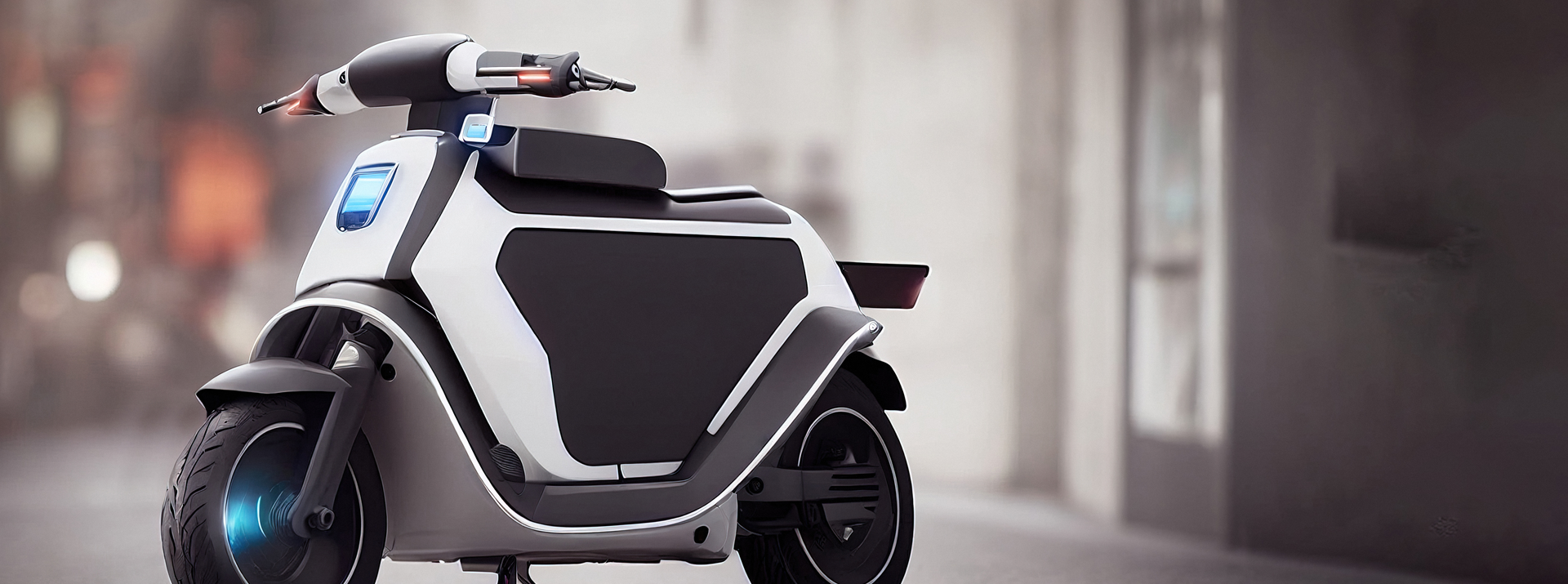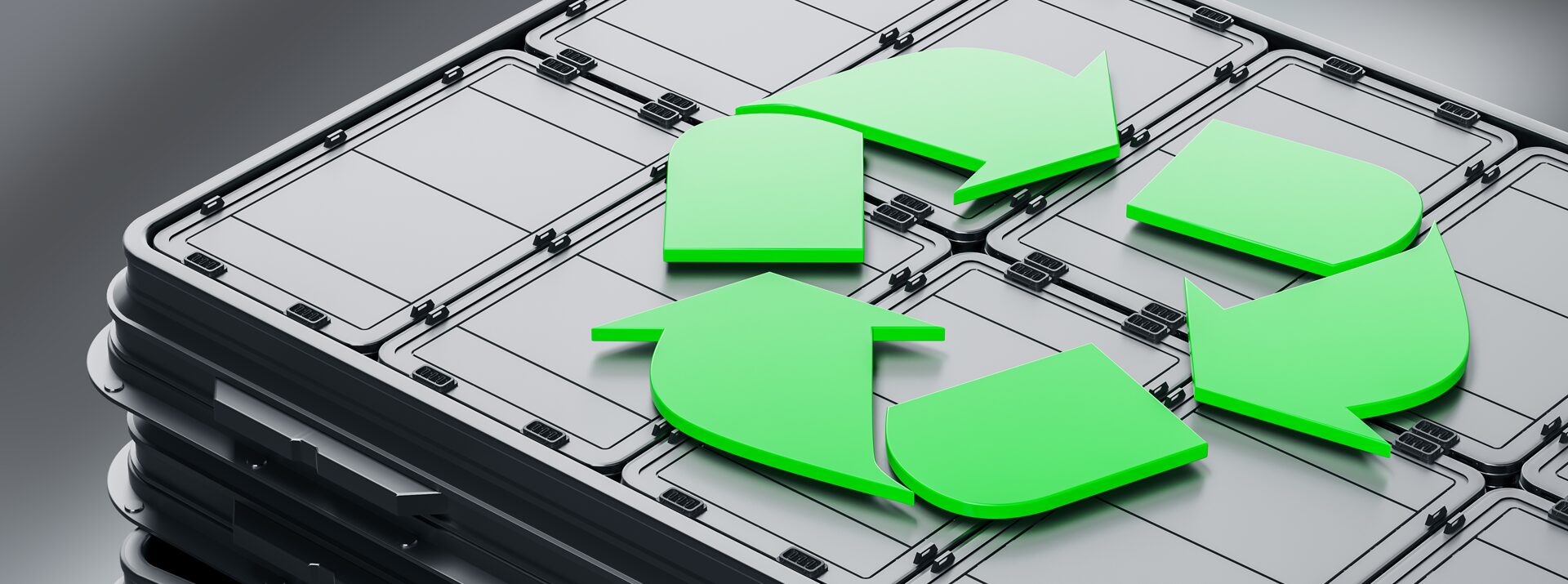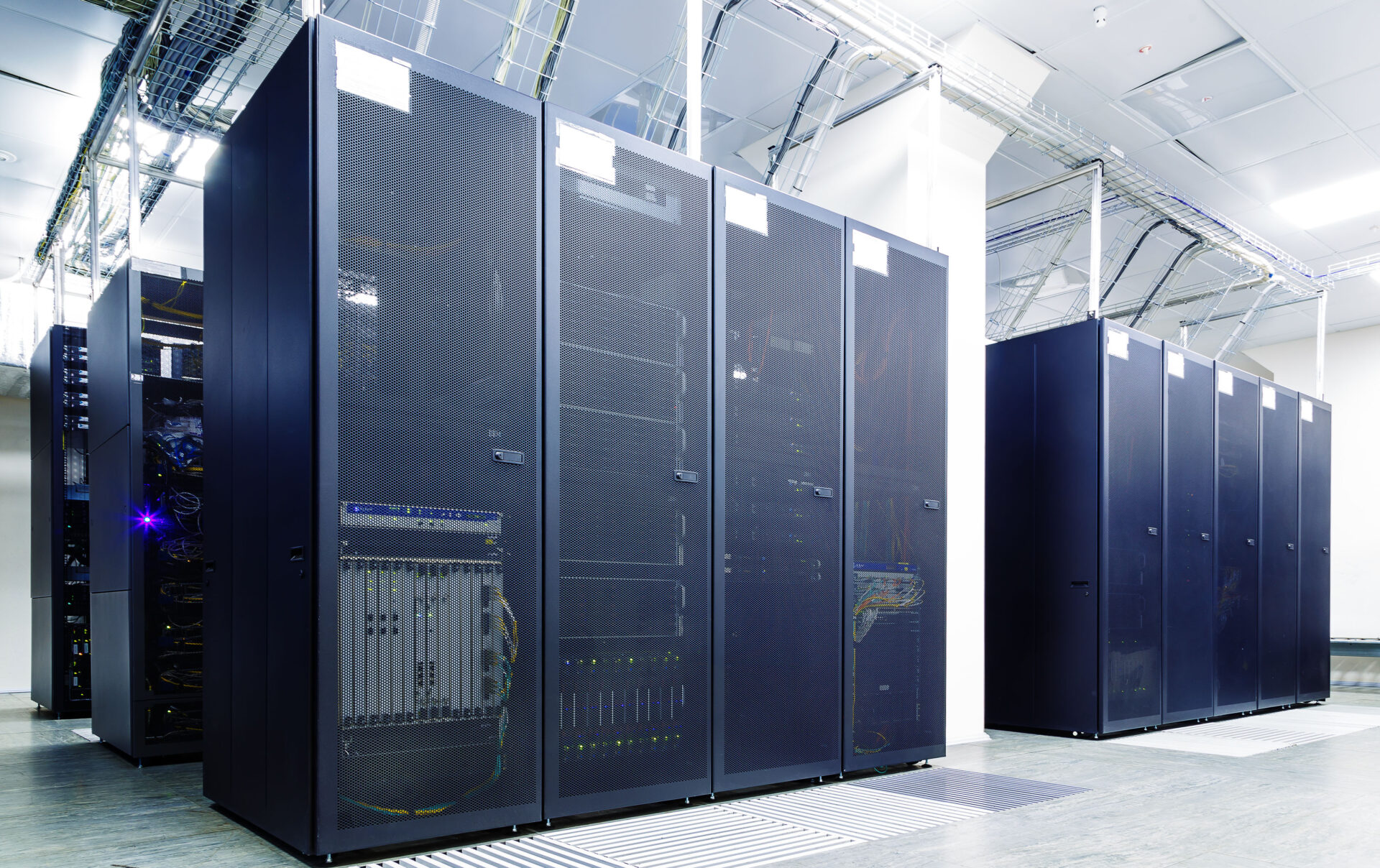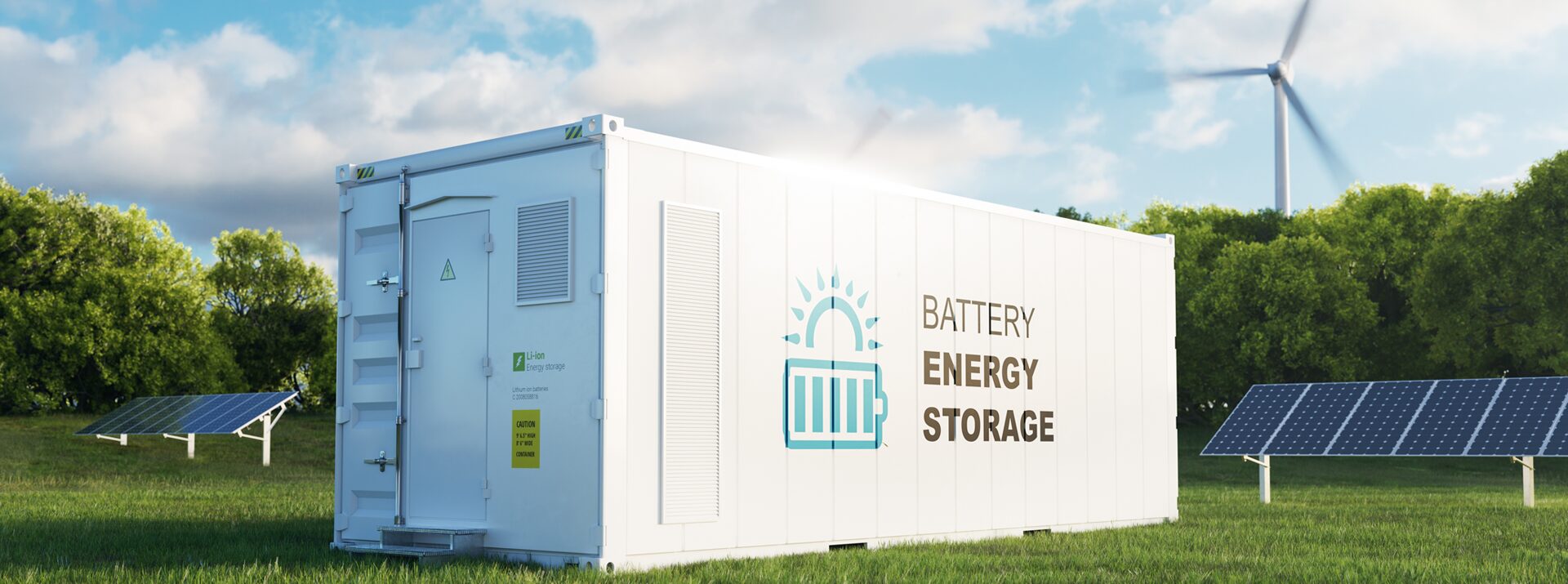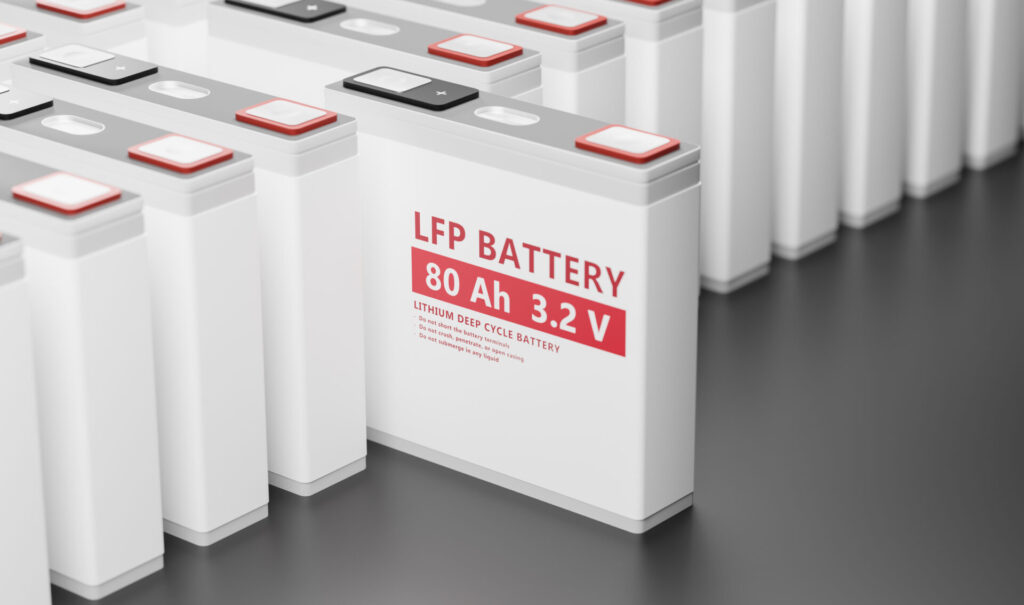
- Electronic Components
What is “SCP”? – Protections of lithium (Li) -ion batteries from errors such as overcharging, overcurrent
目次
Beneficial properties of Li-ion batteries
Li-ion batteries serve as the power source for devices such as smartphones and laptops. As technology has advanced, these batteries have become smaller and more powerful, and are now also used in drones and electric bikes. It’s fair to say that Li-ion batteries are essential in our daily lives. They are utilized in a broad range of applications due to the following three key advantages:
- High voltage and high energy density
Li-ion batteries deliver approximately three times the voltage (nominal voltage of 3.7 V) of similar-sized nickel-cadmium (NiCd) or nickel-metal hydride (NiMH) batteries (both with a nominal voltage of 1.2 V). This higher nominal voltage means they can produce the same voltage with fewer cells compared to conventional batteries. Additionally, they have a higher energy density than other batteries, resulting in smaller and lighter products. - Self-discharging properties
The self-discharge rate of a Li-ion battery is about 5% per month, which is less than one-fifth of the rate of NiCd or NiMH batteries. This means that even if the battery is left unused for several months, it will still retain about the same amount of energy as a conventional battery that has been left unused for one month. - No memory effect
In conventional NiCd and NiMH batteries, repeated partial charging reduces the overall battery life, a phenomenon known as the “memory effect”. Li-ion batteries do not have this memory effect, allowing for repeated charging.

Safety of Li-ion batteries s
The figure below illustrates the classification of batteries. The batteries discussed in this article are rechargeable batteries (batteries that can be recharged and used repeatedly), which fall under the category of chemical batteries. Li-ion batteries are high-performance, compact, and lightweight batteries that significantly outperform conventional batteries used in electronic devices. Despite the advantages of Li-ion batteries, challenges remain, such as the risk of overcharging.

The following are typical active materials and electrolytes for the positive and negative electrodes that constitute standard rechargeable batteries (lead-acid batteries, NiCd batteries, NiMH batteries, and Li-ion batteries). Water is used as the solvent for electrolyte in all batteries except Li-ion batteries, which use an organic solvent. This organic solvent enables Li-ion batteries to have a nominal voltage that exceeds the voltage for water electrolysis (1.23 V).

When a nickel-metal hydride (NiMH) or nickel-cadmium (NiCd) battery is charging, the battery voltage gradually increases, peaking near full charge, and then stabilizes. Concurrently, the battery temperature will continue to rise, albeit not significantly. Given the small capacity for its size and the fact that the electrolyte is an aqueous solution (non-flammable), the battery is relatively safe.
In contrast, if a Li-ion battery continues to be charged without any safeguards, both the battery voltage and the battery temperature will continue to rise even after the battery is fully charged (see the figure below).
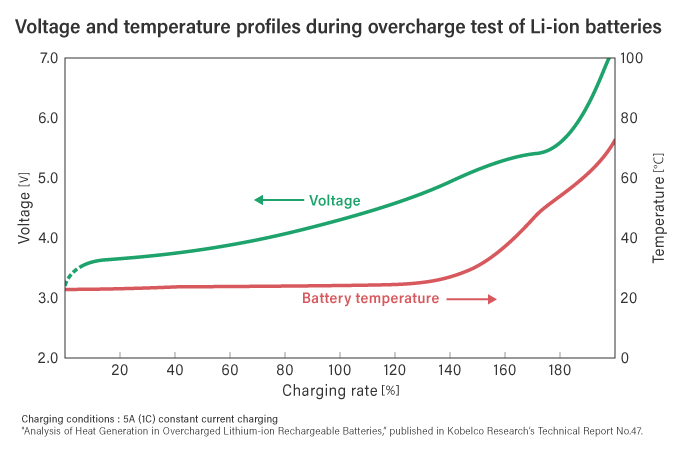
Since the electrolytes in Li-ion batteries consist of flammable organic solvents, overcharging can lead to fire and/or explosion hazards. However, numerous innovations have been made to enhance their performance and safety, leading to their current widespread use.
Secondary protection for Li-ion batteries
Rechargeable batteries, which are used repeatedly, incorporate a Battery Management System (BMS) that monitors and regulates charging and discharging. The BMS is situated between the battery and the device (or charger), and it electronically oversees and manages the battery’s current, voltage, and temperature. The BMS can detect most abnormalities, thereby safeguarding the battery during operation.
However, even the protective functions of electronic circuits can occasionally fail due to abnormalities or semiconductor failures. In the case of lithium-ion batteries, secondary protection is incorporated due to the potential severe consequences of abnormalities, such as fire or explosion. Therefore, a reliable secondary protection method is necessary for enhanced safety.
Self Control Protector (SCP)
The “Self Control Protector” (SCP), developed by Dexerials, is a fuse component that physically disconnects the charge/discharge circuit in the secondary protection of Li-ion batteries. The SCP ensures safety by severing the circuit when the battery becomes unstable or when the primary protection is not functioning correctly. The SCP’s role is to immediately halt the operation of an unstable battery and safely disconnect it from the circuit.
A fuse is a protective component extensively used in electrical devices. It disconnects a circuit by melting the fuse element with Joule heat during an overcurrent. However, in the case of Li-ion batteries, it is necessary to consider not only overcurrent but also overcharge. Since its introduction in 1994, Dexerials’ SCP has been recognized as a standard component of secondary protection fuses for Li-ion batteries, with over 2.84 billion units shipped as of March 2024.
The SCP structure and circuit diagram are shown below.
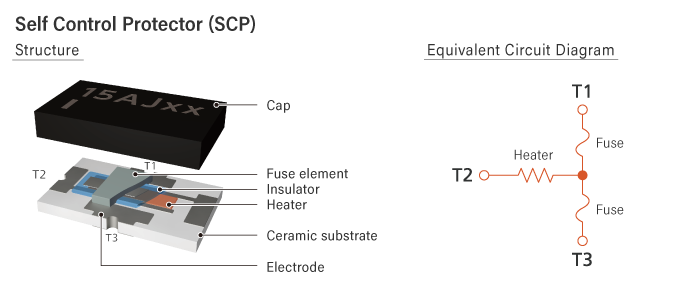
The SCP operates like a conventional fuse during overcurrent, disconnecting the circuit when the fuse element melts, as depicted in Diagram A. However, the SCP’s activation during overcharge is unique. The SCP has a heater beneath the fuse element.
When overcharge occurs, the heater activates and melts the fuse element, cutting off the electric current, as shown in Diagram B below.
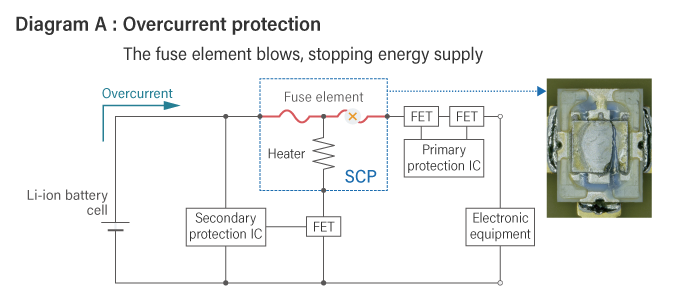
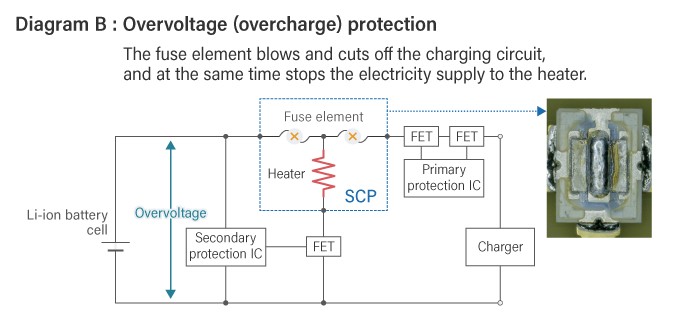
The potential and future of SCP
For approximately 30 years, Dexerials has been engaged in the research and development of Li-ion battery protection. The SCP has become widely used as a secondary protection fuse for Li-ion batteries and is installed in many laptops where secondary protection is crucial.The performance of batteries has improved significantly, and their applications have expanded to various devices such as digital cameras, smartphones, tablets, power tools, and even electric vehicles. Recently, unexpected needs such as “quick charging” have emerged, necessitating further improvement of the SCP. Dexerials will continue our research and development efforts to support the innovation of safer and more convenient batteries.
For devices such as Smart phones and tablets:
SCP plays an important role in preventing the battery from being overcharged or over-discharged in these devices. It contributes to extending battery life and improving safety, greatly improving the user experience. (For more information, please see the article "Secondary protection Fuse (SCP) Technology for Fast-Charging Smart phones").
Power tools:
In the power tool field, where high durability and safety are required, the SCP functions as an important safety device. It protects the safety of the battery even in harsh operating environments, enabling efficient work. (For more information, please see the article "The history of the development of power tools and Dexerials' SCP, the Self-Control Protector (SCP)")
Drone:
Drone, which are experiencing rapid market expansion and technological innovation, require lightweight and highly efficient battery management. SCP is expected to play an important role in maximizing Drone flight time while ensuring safe flight. (For more information, please see the article "The History and Future of Drone- Higher Performance, Longer Flight Time, Higher Voltage, and the Technologies That Support It")
Electric cars and bikes:
In the field of electric vehicles, SCPs improve battery safety and enable long-distance driving. In addition, by supporting high currents, they also contribute to the spread of rapid charging. (For more information, please see the article "Electric motorcycles spreading around the world and their safety (batteries and Secondary protection fuses)").
The evolution of SCPs will not stop, and we will continue to work on developing safer and more efficient protection elements for lithium-ion batteries, aiming for "smaller size" and "higher current". We also have an article about the development process (" The Potential of Secondary protection Fuses (SCPs) -- New Markets Opened Up by Functions to Counter Overcharge and Overcurrent") available. Please take a look.
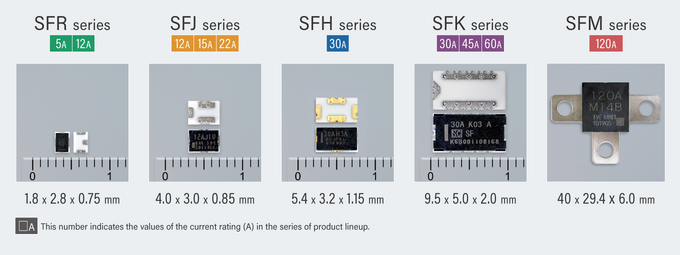
Related articles
- SHARE

We provide materials regarding our products and manufacturing technologies.
Feel free to download it for free.
Download Materials
We provide materials regarding our products and manufacturing technologies.
Feel free to download it for free.
Download Materials







